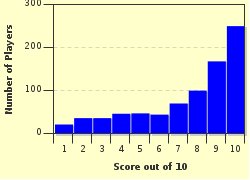Quiz Answer Key and Fun Facts
1. In maths a standard equation would be something along the lines of 'y = x^2'. This equation, when computed, generates a line on a graph that is a parabola that passes through the origin. If you go through the differentiation process of the equation 'y = x^2' with respect to 'x' just once, what would be the result?
2. Take 'y = x^3 + 2x^2 + 4' to be the equation of a curve. If this equation is then differentiated with respect to 'x' it would become the derivative, 'dy/dx = 3x^2 + 4x'. What characteristic of the curve does this derivative represent?
3. The notation involved in calculus can often be confusing and can sometimes obfuscate the actual mathematics. As this particular branch of mathematics was established independently and simultaneously by two mathematicians, Leibniz and Newton, there exists more than one type of notation for the same concept!
If you have a function, say f(x), then which of the following would be the Lagrange notation of the derivative of f(x)?
4. Calculus integrates well with the rest of mathematics. Sorry, I just couldn't resist the pun! It is possible to use calculus with respect to trigonometric functions such as sine, cosine and the myriad of others. When first learning the list of derivatives of trigonometric functions one could be forgiven for thinking that the subject is a little tedious but what is the derivative of 'sin(x)'?
5. Very often trigonometric expressions aren't as simple as just 'sin(x)' or 'tan(x)'. For example a curve, y, could take the form of 'sin(4x)' where the 'x' term has been multiplied by four. The derivative of 'y = sin(4x)' is 'dy/dx = 4.cos(4x)'. What method could have been used to obtain that derivative?
6. The trigonometric functions used in mathematics could be described as a web of functions that are somehow related. To get from one trigonometric function to another could take one or more steps and this is where calculus comes in. What is the derivative of 'tan(x)'?
7. The process of differentiation is remarkably flexible and many mathematicians have slaved over their chalkboards in order to develop methods of finding the derivatives of more complex expressions. Which of the following rules would one have to use if they were asked to find the derivative of 'y = x.sin(x)'?
8. In cases such as those where there exists a complicated curve the 'y' terms and 'x' terms can be expressed in terms of another variable such as 't'. For example, 'x = cos^3 (t)' and 'y = sin^3 (t)' could be the two equations given. If you differentiated 'x' with respect to 't' and 'y' with respect to 't' and subsequently formed a quotient to ascertain 'dy/dx', what form of differentiation had been used?
9. In calculus it sometimes happens that one needs to differentiate something with respect to something completely different. Take the equation '2y^2 = 3x^3' and consider how to differentiate this equation with respect to 'x'. The right hand side of the equal sign is straightforward enough but by what form of differentiation would one find the derivative of the left hand side of the equal sign?
10. In the field of calculus there is an opposite function to differentiation. What is the name of this function that is used to determine the area under a curve?
Source: Author
jonnowales
This quiz was reviewed by FunTrivia editor
crisw before going online.
Any errors found in FunTrivia content are routinely corrected through our feedback system.

